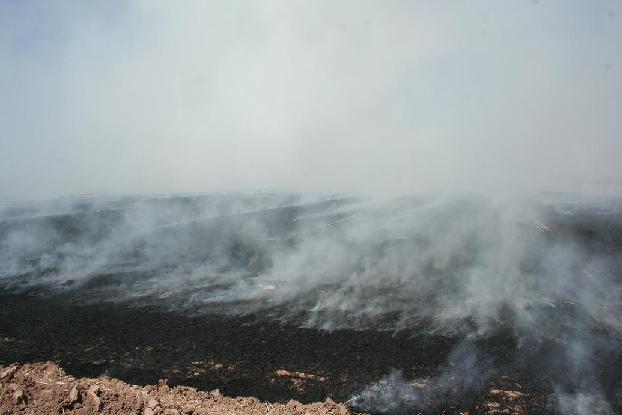 |
|
|
|

|
|||
| |
|||
Vegetation management with fire is a very old technique used in agriculture. It dates back to prehistoric times but is still used today. Fire is a part of nature and is necessary to maintain many grassland and forest ecosystems. It is used in this region primarily as a post harvest technique to remove dead or dormant plant material. It is most commonly used in the summer after grain is harvested to facilitate ground preparation for the next crop or in the spring prior to regrowth of bermudagrass to remove stubble and stimulate regrowth. One of the benefits of burning is that it can be effective in killing weed seeds. The effect of fire on weed seeds has been the subject of many studies and is dependent on many variables. These include the weed type and species, the depth of the seed in the soil, the heat of the fire and the duration of the fire. The type and species of weeds that have been found to be most affected by burning are summer annuals. Weeds that produce seeds with hard seed coats are the least affected. These include sweet clovers, mallow, dodder, sesbania and others. Fire has little affect on creeping perennials, especially during the dormancy period. These include bermudagrass, field bindweed, perennial johnsongrass and nutsedge, all of which have below ground reproductive structures. In weeds that have become established, seedling grasses are more sensitive to fire than seedling broadleaves. This is primarily because the growing points of many grasses are below the soil while the growing points of broadleaves are above the soil and unprotected. Seeds that are burned before they become viable are also more sensitive to fire. The depth of weed seed in the soil also will affect sensitivity to fire. In one study, 88% of the seed that was located in the top 1mm of soil was killed while only 18% of the seed buried 5 mm (0.19") into the soil was killed. Tillage following burning can also be expected to bring up viable seed. The effect of temperature on seed viability has also been the subject of many studies. In most, the germination of summer annuals increased with rising temperature to about 140°F and dropped off rapidly as temperatures approached 212° F. Imbibed seeds were also more sensitive to fire than unimbibed seeds. In addition to temperature, the duration of the fire has been found to affect seed mortality. Hot, slow fires kill many more weed seeds to greater depths than do light, flash fires that raise the temperature only in the top layer of soil. At one experimental site, wheat stubble with longer straw burned longer and hotter than stubble that was short. Burning Wheat Stubble To contact Barry Tickes go to: btickes@ag.arizona.edu. |
|||
| Back | |||
For questions or comments on any of the topics please contact Marco Pena at the Yuma Agricultural Center. |
|||
| Home | Cotton
| Veggies | Forages
| Grains | Citrus
| Crop x Crop Insects | Diseases| Weeds | Pesticides | Economics | News | Weather | Research | Photos | Contacts | General Info. Copyright © 2001 University of Arizona, College of Agriculture and Life Sciences Webmaster: Al Fournier (acis@ag.arizona.edu) |
|||
